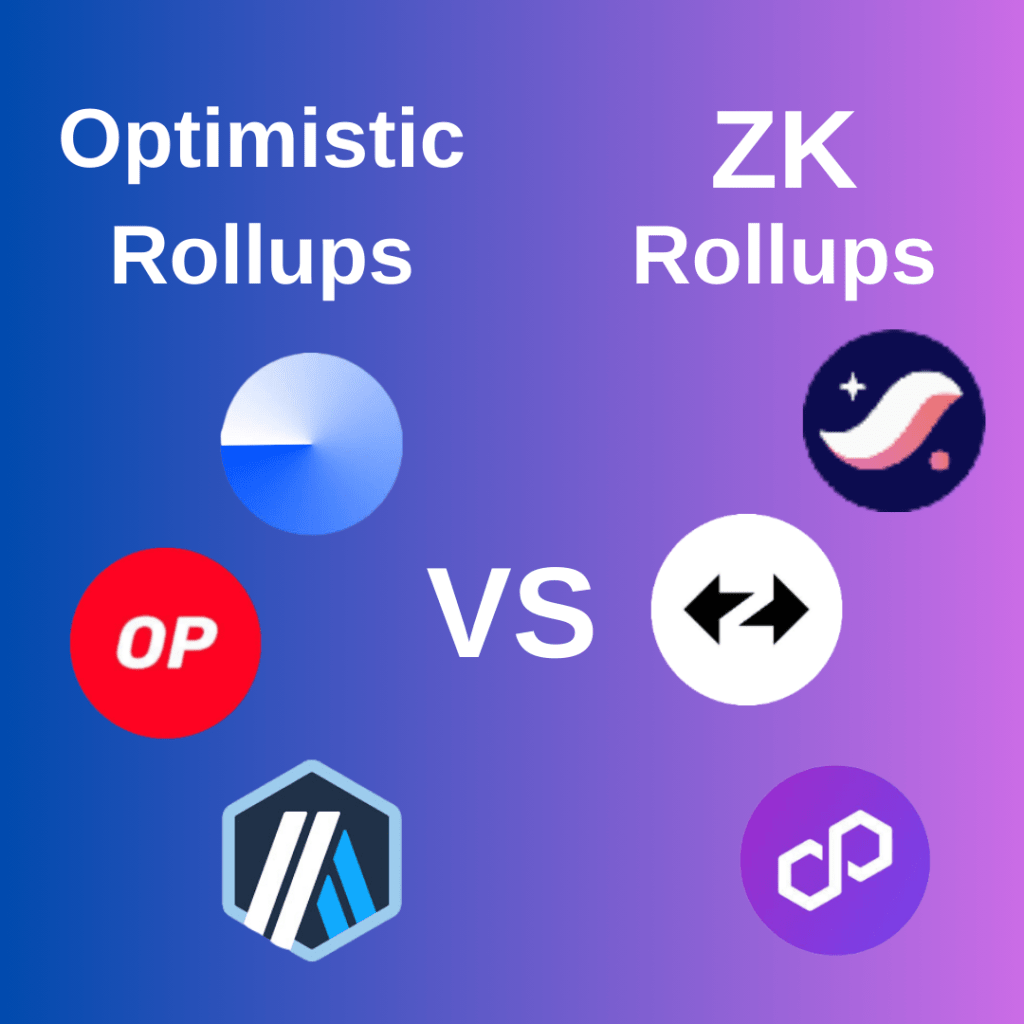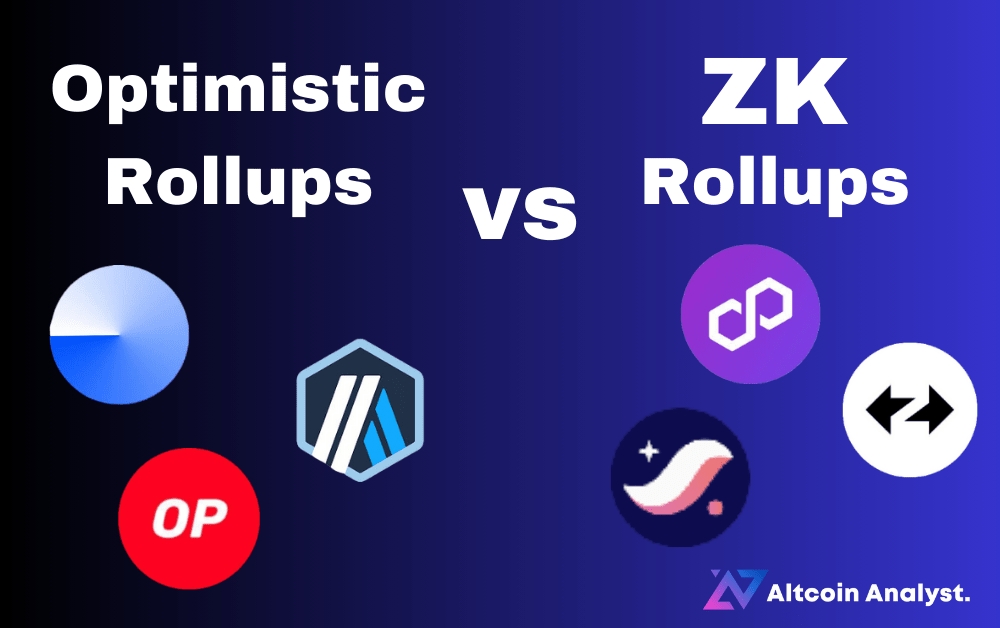

Ethereum, the world’s leading programmable blockchain, has faced challenges keeping up with surging user demand in recent years. This has resulted in high transaction fees and slow processing times, hindering the network’s scalability.
To address these limitations, layer 2 scaling solutions have emerged as a prominent solution. Among these, optimistic rollups and zero-knowledge rollups are at the forefront of the Ethereum scaling race. But with both vying for dominance, a question arises: which one reigns supreme for building decentralized applications (dApps)?

Before diving into the specifics of optimistic and zero-knowledge rollups, let’s establish a common ground. A rollup is a layer 2 scaling solution that processes transactions off-chain, bundling them into batches before submitting them to the main Ethereum blockchain (layer 1). This significantly reduces congestion on the main chain, leading to faster and cheaper transactions. There are primarily two types of rollups: optimistic rollups and zero-knowledge rollups.
Feature | Optimistic Rollups | Zero-Knowledge Rollups |
| 1. Security | Relies on fraud proofs from validators | Uses mathematical proofs for validation |
| .2 Security Advantage | Only one honest node needed to submit a fraud proof | Stronger security guarantees |
| 3. Security Disadvantage | Vulnerable if no honest nodes challenge invalid transactions | Centralization risk due to specialized hardware requirements |
| 4. Cost | Lower computation costs due to no special hardware | Lower data storage costs due to efficient compression |
| 5. Cost Disadvantage | Higher fees due to posting all transaction data on layer 1 | Higher fees due to complex hardware requirements |
| 6. Transaction Finality | High latency due to challenge period | Lower latency due to immediate state updates after proof verification |
| 7. Transaction Finality Disadvantage | Transactions can be reversed during the challenge period | Slower proof generation can increase latency |
| 8. Privacy | Less user privacy as transaction data is visible | Higher user privacy as transaction details are hidden |
| 9. Capital Efficiency | Lower capital efficiency due to locked funds during dispute period | Higher capital efficiency due to anytime withdrawals |
| 10. EVM Compatibility | Fully compatible with EVM and Solidity | Limited EVM compatibility, requires new languages and frameworks |
| 11. Development Ease | Easier development due to existing tools and languages | More complex development due to new programming requirements |
Source: https://blog.thirdweb.com/optimistic-rollups-vs-zero-knowledge-zk-rollups/
Optimistic Rollups: These rollups operate on the principle of “optimistic validity.” They assume all transactions are valid by default. However, a mechanism exists to dispute fraudulent transactions. If a validator suspects foul play, they can submit a “fraud proof” to the main Ethereum blockchain. This proof demonstrates the invalidity of a particular transaction.
The advantage of this approach is that only one honest node is needed to submit a fraud proof and maintain network security, however the time window for challenge periods ensures that even if the network is momentarily “dishonest,” there is a chance to revert invalid transactions. Additionally, economic incentives encourage validators to act honestly, as they can potentially earn rewards for identifying and disputing fraudulent transactions.
However, a potential weakness exists. If all validators are malicious or negligent, they might fail to submit a fraud proof for a truly invalid transaction. This could lead to stolen funds if left unchecked.
ZK-Rollups: Instead of relying on fraud proofs, ZK-Rollups utilize cryptographic proofs called “zero-knowledge proofs” (ZKPs) for transaction validation. ZKPs allow validators to verify the validity of a transaction without revealing the actual transaction details.
This offers a strong security advantage as the validity of transactions is guaranteed by mathematical proofs rather than relying on the honesty of validators. However, there’s a trade-off. Generating ZKPs requires specialized and powerful hardware. This can lead to a degree of centralization, as only a few entities might have the resources to operate these high-performance machines.
Additionally, the complexity of ZKPs can introduce potential vulnerabilities if not implemented correctly.
Optimistic Rollups: These rollups benefit from lower computation costs because regular layer 2 nodes can compute fraud proofs. This eliminates the need for expensive specialized hardware. However, a hidden cost exists. Optimistic rollups require posting all transaction data on the main Ethereum blockchain, even though only a compressed version is used for computation on the layer 2 network. This can lead to higher gas fees, especially for transactions involving large amounts of data.
ZK-Rollups: ZK-Rollups excel in data compression techniques. They represent user accounts with an index rather than the full address, saving a significant amount of data. This translates to lower fees for publishing transaction data on the base chain. However, the computational complexity of ZKPs comes at a cost. Generating and verifying ZKPs requires powerful hardware, which can be expensive to obtain and maintain. It is worth mentioning that some newer ZK-rollup implementations (e.g., Polygon’s zkEVM) are making strides in reducing the hardware burden for generating proofs so we expect the complexity issue to be addressed as the technology matures.
Optimistic Rollups: These rollups face a trade-off between speed and security when it comes to transaction finality. Transactions are considered “unfinalized” until a predefined “challenge period” elapses on the main chain. This period allows validators to submit fraud proofs in case of any issues.
While users receive immediate confirmation on the layer 2 network, they must wait for the challenge period to expire before the transaction is permanently secured on the main chain. This waiting period can range from minutes to hours depending on the specific rollup protocol.
The advantage of this approach is that it allows for fast transaction processing on the layer 2 network. However, the delay in finality can be inconvenient for users who require immediate certainty about their transactions.
ZK-Rollups: ZK-Rollups offer faster transaction finality compared to optimistic rollups. Once the validity proofs are verified by the node operators, the transaction is considered finalized and the state is updated. This eliminates the need for a challenge period, leading to a more immediate finality for transactions. However, the speed advantage comes at a cost. Generating and verifying ZKPs can be computationally intensive, potentially adding some latency to the overall transaction processing time.
Optimistic Rollups: These rollups offer less user privacy compared to ZK-Rollups. Since all transaction data is posted on the main chain, it remains publicly accessible for on-chain analytics tools. This allows anyone to potentially identify users and track their transactions. While some optimistic rollup protocols might employ additional privacy-preserving techniques, they often come at the expense of increased complexity or reduced functionality.
ZK-Rollups: ZK-Rollups prioritize user privacy. They leverage the power of ZKPs to ensure transaction validation without revealing any sensitive information about the transaction itself. This means only the validity of the transaction is proven, not the specific details like sender, receiver, or amount. This approach offers a significant privacy advantage for users who value anonymity and confidentiality in their blockchain interactions.
Optimistic Rollups: The challenge period in optimistic rollups introduces limitations on capital efficiency. Since transactions are not finalized until the period expires, users cannot withdraw their funds immediately. This can be inconvenient for users who require immediate access to their funds.
ZK-Rollups: ZK-Rollups offer superior capital efficiency due to the absence of a challenge period. Once a transaction is validated, users can withdraw their funds instantly. This allows for greater flexibility and control over user funds within the ZK-Rollup ecosystem.
Optimistic Rollups: These rollups boast full compatibility with the Ethereum Virtual Machine (EVM) and the Solidity programming language. This makes them highly developer-friendly. Existing Ethereum developers can easily port their Solidity-based smart contracts to optimistic rollups without needing to learn new languages or frameworks.
Additionally, they can leverage the extensive ecosystem of tools and libraries already available for Ethereum development. This ease of use lowers the barrier to entry for developers looking to build decentralized applications (dApps) on optimistic rollups.
ZK-Rollups: Limited EVM compatibility is a current hurdle for ZK-Rollups. While significant progress is being made in improving EVM compatibility, many ZK-Rollups still require developers to use alternative languages and frameworks specifically designed for their platform. This can create a learning curve for developers accustomed to working with Solidity and the EVM. The lack of a standardized development environment can also be a challenge for developers looking to build dApps across multiple ZK-Rollup platforms.
Source: https://metaschool.so/articles/zk-rollups-vs-optimistic-rollups/
DeFi: Optimistic rollups are a perfect fit for Decentralized Finance (DeFi) projects due to their low transaction fees and compatibility with the Ethereum Virtual Machine (EVM). This allows existing DeFi protocols to seamlessly scale to millions of users without compromising affordability. Leading examples include Uniswap and Sushiswap, prominent Ethereum-based DEXs (Decentralized Exchanges) that leverage Optimism’s optimistic rollup technology.
Synthetic Assets with Speed: Protocols like Synthetix, which issues synthetic assets that mirror real-world assets, benefit greatly from optimistic rollups’ fast transaction processing. This enables users to trade these synthetic assets efficiently without encountering high fees or delays.
ZK-powered Identity: Zero-knowledge rollups, with their emphasis on privacy and security, are ideal for decentralized identity verification protocols. Polygon ID, for instance, utilizes ZK-proofs to allow users to verify their identity on-chain without revealing sensitive data. This fosters a more secure and private online identity management system.
Discreet Crypto Trading: DEXs like ZigZag Exchange leverage ZK-rollups to offer secure and private crypto trading experiences. Users can enjoy the benefits of decentralized exchanges without compromising the confidentiality of their trading activities.
It’s important to remember that both optimistic and ZK-rollups have the potential to be used for a wide range of applications beyond the examples mentioned above. They can support the development of virtually any application currently built on Ethereum. However, understanding their strengths in terms of speed, cost, and privacy allows developers to choose the optimal rollup solution for their specific project needs.
Now that we’ve explored the ideal use cases for each type of rollup, let’s see them in action with some real-world examples:
These are just a few examples, and the landscape of rollup-powered applications is constantly evolving. As both optimistic and ZK-rollups continue to mature, we can expect to see even more innovative projects emerge across various sectors.
Optimistic Rollups and ZK-Rollups are powerful solutions for scaling the Ethereum blockchain. However, the choice between them depends on the specific needs of the application. Here’s a quick guideline:
Optimistic Rollups: Ideal for applications that prioritize speed, low development overhead, and cost-effectiveness for transactions with minimal privacy requirements. Use cases include decentralized exchanges, payment processing, and gaming with low-value transactions.
ZK-Rollups: Well-suited for applications where user privacy is paramount, and where fast and final transaction confirmation is crucial. Examples include DeFi applications dealing with sensitive financial data, or applications requiring immediate access to funds after a transaction. In fact, Vitalik Buterin outlined a future where all rollups are zero-knowledge (ZK) rollups. In a post on X, the Ethereum co-founder predicted that within a decade, each rollup will submit finalized block data to the main Ethereum chain for verification (Source: https://www.binance.com/en/square/post/2024-05-21-vitalik-buterin-envisions-all-rollups-to-be-zk-in-a-decade-8386850638009).
As both technologies continue to evolve, the lines between them are blurring. Optimistic Rollups are exploring ways to incorporate privacy-preserving features, while ZK-Rollups are striving for greater EVM compatibility.
Ultimately, the ongoing advancements in both Optimistic Rollups and ZK-Rollups promise a future where developers and users have a wider range of options to choose from, based on the specific requirements of their blockchain applications.
You must be logged in to submit a review.
Copyright ©2025 Altcoin Analyst.